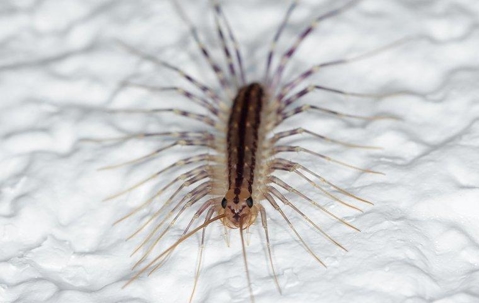There are some pests that are a nuisance and some that are downright frightening. Snakes, spiders, and centipedes all fall into the latter category for many people. Centipedes are known for their long bodies with many legs, and they can be a big problem during the spring. Here’s a guide to identifying centipedes, finding out why they’re in your home, and learning how to keep them out.
How To Identify Centipedes
Centipedes are nocturnal, meaning they’re most active at night. Because of this, you probably won’t see many of them during the day. However, if you see one centipede, there’s a good chance there are more nearby.
Centipedes can range in color from yellow to dark brown. Although their name suggests they have 100 legs, in reality, they can have up to 177 pairs of legs. Fun fact: centipedes always have an odd number of pairs of legs. The house centipede is usually less than two inches long, while the long centipede can grow up to six inches. These pests are fairly easy to identify based on their length and their many legs.
Are Centipedes Dangerous?
Centipedes aren’t as dangerous as some pests because they don’t carry diseases. However, they can bite if threatened, and a centipede bite can be quite painful. Centipedes are also problematic because they attract other pests or might be a sign of a pest problem. They eat flies and spiders and may eat plants as well. If you have centipedes in your home, they’re probably finding other pests to feed on. Centipedes are also a nuisance pest. They can live up to six years, meaning that an unchecked infestation will continue to grow at a relatively rapid pace.
Why Do Centipedes Get Inside?
Before you can learn to eliminate centipedes from your Quad City home, you need to know why they are getting inside. There are three primary attracting factors: moisture, food, shelter. They may come inside for warmth, or because they can find food in your home, or because you can provide a dark, moist environment for them to hide in. Keep reading to find out how you can prevent them from getting inside in the first place.
Keeping Your Home Centipede Free
The best way to keep your home free of centipedes is to focus on prevention. Luckily, there are some ways to do so. The first step in preventing centipedes is to lower the moisture levels in your home and yard. This means using a dehumidifier in damp areas of the home such as the basement. It can also mean watering the lawn less often and making sure there are no puddles near the home.
Another way to prevent pests is to make sure there are no other pests in your home attracting centipedes. One way to do that is to rely on Quik-Kill Pest Eliminators for year-round pest control that targets all common household pests in the Quad Cities.
Finally, you can prevent centipedes by taking some extra time in your spring cleaning to organize storage areas like closets and basements. This will make it harder for centipedes to hide in your home. Along with this cleaning, take a moment to inspect the exterior of your home for holes or cracks that may be allowing centipedes to get inside.
If you need help with centipede prevention or elimination, don’t hesitate to reach out to Quik-Kill Pest Eliminators. We have years of experience eliminating pests like centipedes, and we can help you get your home ready for a pest-free spring.

